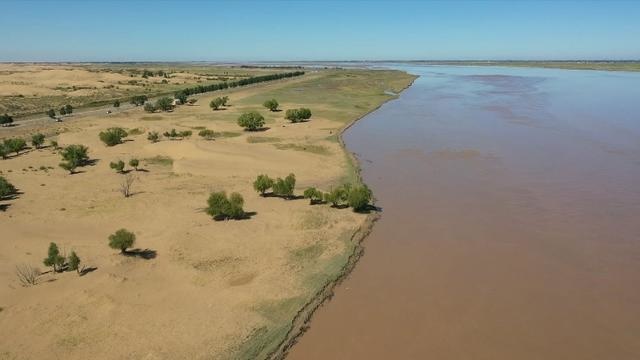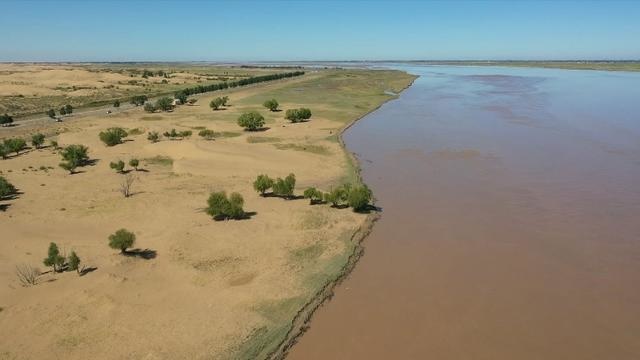By Wu Yong, People’s Daily

Photo shows the hinterland of the Kubuqi Desert with water diverted from the Yellow River. (Photo/nmtv.cn)
As water birds frolicked in a lake near a vast expanse of sand dunes scattered with small bushes and trees in the hinterland of China’s seventh largest desert, Kubuqi Desert, tourists were attracted to the home of a local herdsman by some Mongolian yurts on the roadside.
Narenmandahu, the herdsman, is a 51-year-old villager in Bayinwenduer village, Huhemudu township, Hangjin banner, Erdos, North China’s Inner Mongolia Autonomous Region.
Last year, the man, who is good at raising cattle and crabs, saw the annual income of his family reach 3 million yuan ($448,200), thanks to the efforts of the desertification control by the local governments in recent years.
Narenmandahu’s family has about 586.67 hectares of pastures. Most of the pastures used to be desert areas, which couldn’t provide enough food for cattle and sheep.
In recent years, these pastures have enjoyed great changes.
During the ice-jam flood season in 2014, Hangjin banner took advantage of elevation drops and introduced water from the Yellow River to the hinterland of the Kubuqi Desert for the first time.
In 2018, Hangjin banner won 65.24 million yuan of financial aid for water conservancy projects from the central government. With the funds, the local government has perfected the connectivity of water conservancy facilities that help divert some of the water in the Yellow River to the low-lying areas of the Kubuqi Desert, forming a water circulation pattern in which water is diverted from the Yellow River to the Kubuqi Desert and then flow back to the Yellow River.
The endeavor boosted water ecology in the Kubuqi Desert, and helped form about 66.67 hectares of water areas in the pastures of Narenmandahu’s family. After the water made the grass grow well and livestock be well fed, Narenmandahu started to raise crabs.
The juvenile crabs released into water this summer have recently come into the market around the Mid-Autumn Festival that fell on October 1 this year. Narenmandahu was filled with joy when net after net of big crabs were captured ashore.
In the past, people living in the hinterland of the Kubuqi Desert suffered from difficulties and disasters caused by sand of the desert and water of the Yellow River near the desert, while now water of the Yellow River is used to contain desertification in the desert and has helped turn the hinterland of the Kubuqi Desert into an important source of wealth, said Liu Haiquan, director of the bureau of water resources of Hangjin banner.
“Since 2015, more than 200 million cubic meters of water has been diverted from the Yellow River to the hinterland of the Kubuqi Desert accumulatively, helping form nearly 20 square kilometers of water areas and nearly 60 square kilometers of ecological wetland in the hinterland of the desert,” Liu noted.
Today, over 20 kinds of plants have returned to growth naturally, and more than 10 species of water birds inhabit the area, according to Liu.
As the ecology of the Kubuqi Desert improves continuously in recent years, the livestock farming business of Narenmandahu’s family has also grown day by day.
In 2006, Narenmandahu’s family only had about 20 head of cattle, while now the figure has risen to more than 700.
Like Narenmandahu, many local herdsmen have seen rapid growth in their livestock farming business.
“We have just left Erenhot, and will reach Huhemudu township this evening,” a client told Narenmandahu over the phone. The client wanted to buy more than 100 head of cattle, said Narenmandahu, adding that he had already introduced the buyer to a local family.
Narenmandahu has not only been pursuing prosperity for his family, but helping fellow herdsmen promote sales through his channels.
Since Narenmandahu has more than 20 years of experience in raising cattle, and cattle growing in the desert have a unique delicious taste, the man never had to worry about the sales or profits of his beef.
“Our beef was sold to Shenzhen and Shanghai last year. I’m also thinking about building a refrigeration house to sell vacuum-packed beef in all seasons and further increase the family income,” Narenmandahu told the People’s Daily.
In 2016, the man who became better-off by raising cattle began engaging in aquaculture.
“As I didn’t know much about the work, my fish were washed away by the water during the first year,” Narenmandahu recalled.
However, the setback didn’t frustrate him. Attracted by the good returns from raising crabs, Narenmandahu hired professionals in the field to help him, and achieved success in raising crabs in the desert.
“This year I harvested about 15,000 kilograms of crabs. The retail price for each kilogram of crabs is 25 yuan, and the wholesale price is 17.5 yuan per kilogram,” Narenmandahu noted.
In an effort to make better use of the “golden area”, the man has started to run an agritainment restaurant, and built six Mongolian yurts and a barbecue tent for the business. In addition, he has planted a dozen kinds of ornamental trees and fruit trees to improve the surrounding environment of his restaurant, such as cherry trees and mountain peach trees.
“Tourists can enjoy beef and crabs, and have fun experiencing desert activities and walking in the desert,” Narenmandahu said.
Narenmandahu told the People’s Daily that he planned to raise lobsters the next year, which would mean another source of a handsome income.
“I want to grow lotus over there, which will attract more visitors,” said Narenmandahu confidently, pointing to the water area in front of him.
Narenmandahu, the herdsman, is a 51-year-old villager in Bayinwenduer village, Huhemudu township, Hangjin banner, Erdos, North China’s Inner Mongolia Autonomous Region.
Last year, the man, who is good at raising cattle and crabs, saw the annual income of his family reach 3 million yuan ($448,200), thanks to the efforts of the desertification control by the local governments in recent years.
Narenmandahu’s family has about 586.67 hectares of pastures. Most of the pastures used to be desert areas, which couldn’t provide enough food for cattle and sheep.
In recent years, these pastures have enjoyed great changes.
During the ice-jam flood season in 2014, Hangjin banner took advantage of elevation drops and introduced water from the Yellow River to the hinterland of the Kubuqi Desert for the first time.
In 2018, Hangjin banner won 65.24 million yuan of financial aid for water conservancy projects from the central government. With the funds, the local government has perfected the connectivity of water conservancy facilities that help divert some of the water in the Yellow River to the low-lying areas of the Kubuqi Desert, forming a water circulation pattern in which water is diverted from the Yellow River to the Kubuqi Desert and then flow back to the Yellow River.
The endeavor boosted water ecology in the Kubuqi Desert, and helped form about 66.67 hectares of water areas in the pastures of Narenmandahu’s family. After the water made the grass grow well and livestock be well fed, Narenmandahu started to raise crabs.
The juvenile crabs released into water this summer have recently come into the market around the Mid-Autumn Festival that fell on October 1 this year. Narenmandahu was filled with joy when net after net of big crabs were captured ashore.
In the past, people living in the hinterland of the Kubuqi Desert suffered from difficulties and disasters caused by sand of the desert and water of the Yellow River near the desert, while now water of the Yellow River is used to contain desertification in the desert and has helped turn the hinterland of the Kubuqi Desert into an important source of wealth, said Liu Haiquan, director of the bureau of water resources of Hangjin banner.
“Since 2015, more than 200 million cubic meters of water has been diverted from the Yellow River to the hinterland of the Kubuqi Desert accumulatively, helping form nearly 20 square kilometers of water areas and nearly 60 square kilometers of ecological wetland in the hinterland of the desert,” Liu noted.
Today, over 20 kinds of plants have returned to growth naturally, and more than 10 species of water birds inhabit the area, according to Liu.
As the ecology of the Kubuqi Desert improves continuously in recent years, the livestock farming business of Narenmandahu’s family has also grown day by day.
In 2006, Narenmandahu’s family only had about 20 head of cattle, while now the figure has risen to more than 700.
Like Narenmandahu, many local herdsmen have seen rapid growth in their livestock farming business.
“We have just left Erenhot, and will reach Huhemudu township this evening,” a client told Narenmandahu over the phone. The client wanted to buy more than 100 head of cattle, said Narenmandahu, adding that he had already introduced the buyer to a local family.
Narenmandahu has not only been pursuing prosperity for his family, but helping fellow herdsmen promote sales through his channels.
Since Narenmandahu has more than 20 years of experience in raising cattle, and cattle growing in the desert have a unique delicious taste, the man never had to worry about the sales or profits of his beef.
“Our beef was sold to Shenzhen and Shanghai last year. I’m also thinking about building a refrigeration house to sell vacuum-packed beef in all seasons and further increase the family income,” Narenmandahu told the People’s Daily.
In 2016, the man who became better-off by raising cattle began engaging in aquaculture.
“As I didn’t know much about the work, my fish were washed away by the water during the first year,” Narenmandahu recalled.
However, the setback didn’t frustrate him. Attracted by the good returns from raising crabs, Narenmandahu hired professionals in the field to help him, and achieved success in raising crabs in the desert.
“This year I harvested about 15,000 kilograms of crabs. The retail price for each kilogram of crabs is 25 yuan, and the wholesale price is 17.5 yuan per kilogram,” Narenmandahu noted.
In an effort to make better use of the “golden area”, the man has started to run an agritainment restaurant, and built six Mongolian yurts and a barbecue tent for the business. In addition, he has planted a dozen kinds of ornamental trees and fruit trees to improve the surrounding environment of his restaurant, such as cherry trees and mountain peach trees.
“Tourists can enjoy beef and crabs, and have fun experiencing desert activities and walking in the desert,” Narenmandahu said.
Narenmandahu told the People’s Daily that he planned to raise lobsters the next year, which would mean another source of a handsome income.
“I want to grow lotus over there, which will attract more visitors,” said Narenmandahu confidently, pointing to the water area in front of him.
 Menu
Menu
 Herdsman living in hinterland of N China’s Kubuqi Desert becomes better off
Herdsman living in hinterland of N China’s Kubuqi Desert becomes better off
















